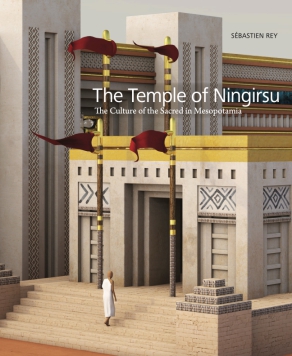The Temple of Ningirsu
The Culture of the Sacred in Mesopotamia
Sébastien Rey
Between 2016 and 2022, a team from the British Museum conducted excavations in the ancient Sumerian city of Girsu, the sacred center of the state of Lagash. On an archaeological mound referred to as the Mound of the Palace, or Tell A, they discovered the ground plan of the fabulous Temple of Ningirsu, built by the ruler Gudea circa 2125 BCE. Deep in the heart of the mound, the excavators also exposed the remains of a series of older Sumerian shrines dating back to Early Dynastic times (2900–2350 BCE).
- Description
- Bio
- Table of Contents
- Sample Chapters
The magnificent remains of Sumerian Girsu were first investigated by groups of French archaeologists between 1877 and 1933. Digging at great speed and using the industrial-scale methods characteristic of their era, the French pioneers unearthed extraordinary buildings and treasures, but they also left behind an unhappy legacy of confusion and gaps in the archaeological record. This two-volume study not only presents the new results of the British Museum team; it also reconsiders and recontextualizes the French reports to produce an indispensable history of the sacred complexes in Girsu over a period of nearly three thousand years. With full-color reconstructions of the principal buildings and installations, as well as many redrawn plans and sections, this lucidly written study reexamines the history of the exceptionally complete series of archaeological structures built on Tell K and Tell A from the beginning of the third millennium BCE to the fourth and third centuries BCE.
Sébastien Rey is the curator for ancient Mesopotamia at the British Museum and director of the Girsu Project in Iraq. Among his most recent publications are For the Gods of Girsu: City-State Formation in Ancient Sumer, No Man’s Land, and Thunderbird: A Temple Hymn from Ancient Sumer.
List of Illustrations
List of Abbreviations
Part 1: General Introduction
CHAPTER 1 The Temple of Ningirsu from Its Origins to the Present Day
CHAPTER 2 The Rediscovery of Ancient Girsu
CHAPTER 3 A Contextualised Chronology of Ancient Girsu
Part 2: The Mound of the House of the Fruits
CHAPTER 4 Introduction to the French Excavations on Tell K
CHAPTER 5 The French Excavations on Tell K: Sarzec and Heuzey in Detail
CHAPTER 6 After Sarzec: Cros in Detail
CHAPTER 7 The Great Rift of Girsu: Genouillac and Parrot
CHAPTER 8 Tell K: Plans and Sections
CHAPTER 9 Photographs of Tell K, 1888–1931
CHAPTER 10 Tell K: A New History of the Temple of Ningirsu
CHAPTER 11 The Origins and Early Historical Significance of the Temple of Ningirsu
CHAPTER 12 The Lower Construction
CHAPTER 13 The Objects from the Lower Construction
CHAPTER 14 The Tessellated Earth
CHAPTER 15 The Outer Block (P′Q′R′S′) and Associated Finds
CHAPTER 16 The New Sanctuary: The Ur- Nanshe Building
CHAPTER 17 The Eanatum Extension Phase
CHAPTER 18 The Stele of the Vultures
CHAPTER 19 The Enmetena Restoration
CHAPTER 20 From Enmetena to the Destruction of the Early Dynastic Complex
CHAPTER 21 Darkness and Renaissance: Tell K in the Akkad, Lagash II and Ur III Eras
Part 3: The Mound of the Palace
CHAPTER 22 An Overview of the French Excavations on Tell A
CHAPTER 23 The French Pioneers on Tell A: An In- Depth Account of Their Findings
CHAPTER 24 Plans of the French Excavations and a Plaster Maquette
CHAPTER 25 Photographs of the Early French Excavations
CHAPTER 26 The French Legacy: Challenges and Preserved Treasures
CHAPTER 27 The Mound of the Palace Today: A Landscape of Trenches and Spoils
CHAPTER 28 First Excavation Results: The French Historical Phase (1877–1930)
CHAPTER 29 The Effects of Modern Looting
CHAPTER 30 Coda: Objects from the Spolia of Tell A
CHAPTER 31 Before the Big Move: The Early Dynastic and Akkad Temple Complex
CHAPTER 32 The Early Dynastic Sanctuary of the Goddess Bau
CHAPTER 33 The Ur- Bau Complex: The Relocated Ningirsu Temple and the Restored Temple to Bau
CHAPTER 34 The Gudea Sanctuary of Ningirsu: The New Eninnu
CHAPTER 35 The Historical Significance of the New Eninnu from Lagash II Times to the Old Babylonian Period
CHAPTER 36 The New Eninnu from Lagash II Times to the Old Babylonian Period
CHAPTER 37 The Statues of Gudea from the New Eninnu
CHAPTER 38 Gudea’s Temple Plan and the Physical Remains
CHAPTER 39 The Metrology of Statue B
CHAPTER 40 The Gates of the New Eninnu and the Monuments to the Slain Heroes
CHAPTER 41 The Steles of Gudea
CHAPTER 42 The Bricks of the New Eninnu
CHAPTER 43 The Inscribed Clay Nails of the New Eninnu
CHAPTER 44 The Foundation Deposits of the New Eninnu
Part 4: The Ningirsu Temple in the Hellenistic Era
CHAPTER 45 The Renaissance of the Eninnu
CHAPTER 46 The Stratigraphy of the Hellenistic Shrine
CHAPTER 47 The Meaning and Purpose of the Hellenistic Eninnu
CHAPTER 48 The End of the Hellenistic Eninnu
Acknowledgments
Table of Correspondences
References
Illustration Credits
Index
Download a PDF sample chapter here: Chapter 1
Mailing List
Subscribe to our mailing list and be notified about new titles, journals and catalogs.






